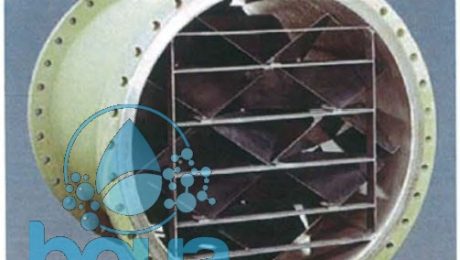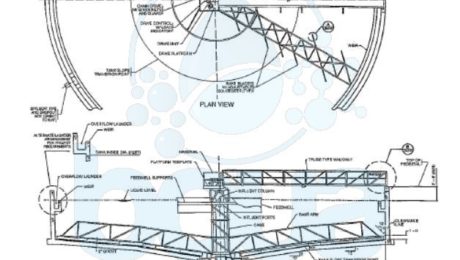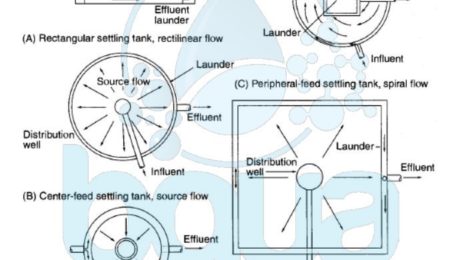What is Coagulation Definition
Coagulation is simply the process that destabilizes colloidal particles so that they can come together to form larger, conglomerate particles. Low-pressure membrane technology is becoming significantly more prevalent in the drinking water industry. Low-pressure membranes are purely size-exclusionary devices. As a result, anything smaller than membrane pore sizes (approximately 0.01 to 0.1 micron) will pass through the membrane, Therefore, membrane feed waters with dissolved materials, such as organics and metals, require some form of additional treatment.
Often, in these cases, the most economical pre-treatment process is simple coagulation. Potential coagulants for membrane pre-treatment include those also used for conventional water treatment. Additionally, organic adsorption media such as PAC and MIEX, or oxidants such as potassium permanganate, chlorine, or chlorine dioxide can be applied upstream of a low-pressure membrane (assuming appropriate membrane compatibility) for enhanced dissolved material removal.
Similar to a direct filtration mode of operation for conventional technology, the goal of coagulation for membrane pretreatment is to produce a pinpoint floc that is capable of adsorbing dissolved matter, but minimizes solids loading onto the membrane filtration process. As noted briefly above, it is important to quantify membrane compatibility and performance with the coagulant of choice.
Each commercially available RO membrane utilizes different membrane materials. As a result, the compatibility and performance of a coagulant for membrane filtration pre-treatment will likely vary between membrane system and raw water supplies. As such, there are no specific guidelines for membrane system pre coagulation except the general guidelines that are associated with conventional treatment.
Coagulant Types
The coagulant most frequently used for membrane plant source seawater conditioning prior to sedimentation or filtration is ferric salt (ferric sulfate and ferric chloride). Aluminum salts (such as alum or polyaluminum chloride) are not typically used because it is difficult to maintain aluminum concentrations at low levels in dissolved form because aluminum solubility is very pH dependent. Small amounts of aluminum may cause mineral fouling of the downstream Seawater Reverse Osmosis membrane elements. In coagulation, coagulant dosage for a given source water should be determined based on jar test and/or pilot testing. The optimum coagulant dosage in a coagulation process is pH dependent and should be established based on an on-site jar or pilot testing for the site-specific conditions of a given application.
Overdosing of a coagulant used for seawater pretreatment is one of the most frequent causes for SWRO membrane mineral fouling. When overdosed during coagulation, coagulant accumulates on the downstream facilities and can cause fast-rate fouling of downstream cartridge filters following the pretreatment step and in iron fouling of the Seawater RO membranes. The effect of overdosing of coagulant (iron salt) on the SDI level can be recognized by visually inspecting the SDI test filter paper (Figure 6). In such situation, a significant improvement of source water SDI can be attained by reducing coagulant feed dosage or in case of poor mixing, modifying the coagulant mixing system to eliminate the content of unreacted chemical in the filtered seawater fed to the SWRO membrane system.
In line static mixer used in coagulation
The main purpose of the coagulation system is to achieve uniform mixing of the added coagulant with the source seawater and efficient coagulation of the particles contained the seawater. The two types of mixing systems most widely used in seawater desalination plant is in line static mixer and mechanical flash mixer installed in coagulation tanks. Although in-line mixers are simple and less costly, they have two disadvantages: (1) their mixing efficiency is a function of the flow rate; (2) static mixers are proprietary equipment and the project designer would need to rely on the equipment manufacturer for performance projections.
Static mixers also create additional head losses of 0.5 to 1.0 meters, which need to be accounted for in the design of the intake pump station. Another important issue is to provide adequate length of pipeline (at least 20 times the pipe diameter) between the mixer and the entrance to the pretreatment filters in order to achieve adequate flocculation. Mechanical flash mixing systems consist of coagulation tank with one or more mechanical mixers and chambers. The coagulation tank is designed for a mixing time (t) of 1 to 3 seconds and mechanical mixers that create velocity gradient (G) of 300 s, (optimum G x t = 500 to 1,600). The power requirement for the mechanical mixer is 2.2 to 2.5 horsepower/10,000 m3/day. This type of mixing usually provides a more reliable and consistent coagulation, especially for desalination plants with significant daily flow variations (i.e., more than 30 % of average annual production flow).
- Published in Water Chemistry, Water Treatment
What is Sedimentation ?
After coagulation occurs followed by a flocculation process before entering a sedimentation basin / clarifier. Flocculated particles enter a sedimentation basin and begin to settle. Particles also referred to as sediments agglomerate to form larger flocs. This process is called sedimentation. When flocs / particles enter a basin and then start to settle, particles’ settling velocities change as particles agglomerate and form larger floc. Because the settling properties of flocculant suspensions cannot be formulated, a clarifier / sedimentation basin performance cannot be accurately predicted. However, for new plants, settling rates can be estimated from batch settling data developed with laboratory jar tests. For expanding existing plants, settling rates can be derived from evaluating the performance of existing basin during various influent water quality conditions. These evaluations often allow for increasing rates for existing basins and establishing higher rates, as compared to published guidelines, for new basins. In an ideal continuous flow basin, sedimentation would take place as it does in the laboratory jar. However, in a real clarifier, wind, temperature density currents, and other factors cause short-circuiting, disruption of flow patterns, breakup of floc, and scouring of the settled sludge. The designer must learn as much as possible about the settling properties of the flocculated solids and then design to match these characteristics. When the designers do not have access to source water data, it is best to select design criteria known to have worked in similar applications, either from personal experience or from regulatory guidelines.
Sedimentation Design Approach
The primary approach in designing conventional sedimentation basins is to select a design overflow rate for maximum expected plant flow. This rate may be chosen based on all units being in service or on one unit being out of service, to allow for redundancy. After selecting a rate, the designer should determine the number of units needed and select the type of sludge collection and removal equipment. The sludge equipment for removing may limit basin dimensions, which could establish the size and num. of units. With the number of basins selected, the designer should proceed to design inlet and outlet conditions and finalize dimensions to suit all design parameters and site conditions. The following are suggested guidelines for the various design parameters.
Sedimentation Overflow Rates
Hydraulic overflow rate is the primary design parameter for sizing sedimentation basins. This rate is defined as the rate of inflow Q divided by the tank surface area A. Units are typically rated in gallons per day per square foot, gallons per minute per square foot, or cubic meters per hour per square meter. Acceptable rates vary with the nature of the settling solids, water temperature, and hydraulic characteristics of the settling basin.
After evaluation of both cold & warm water loading rates, the design rate is based on whichever is more critical. Plant flow variations between warm and cold water periods often allow selection of higher rates for summer operation than the typical suggested loading rates. Overflow rates can also be selected based on pilot studies. Piloting of conventional settling basins is not especially reliable, but it is often done using tube settlers. Data from such studies, along with jar testing, are often useful in design. Pilot testing of other types of settling, especially proprietary processes, is useful and is recommended.
Detention Time
Which is the flow rate divided by tank volume, is usually not an important design parameter. Many regulatory agencies (e.g., Great Lakes, 2003), however, still have a requirement for detention periods of 4 h. It is likely that this detention requirement is a carryover from the days of manually cleaned basins designed to provide the sludge storage zone. These basins were often 15 to 16 ft (4.6 to 4.9 m) deep or greater and operated so that more than one-half the volume could be filled with sludge before being cleaned. Real time could vary from 4 h when clean to less than 2 h just before cleaning. Modern designs with mechanical sludge removal equipment need not provide a sludge zone, and deep basins with long detention times are no longer required. Conventional basins with detention times of 1.5 to 2.0 h provide excellent treatment.
Basin Depth and Velocities
In theory, basin depth should not be an important parameter either, because settling is based on overflow rates. However, in practice, it is important because it affects flow-through velocity. Flow-through velocities must be low enough to minimize scouring of settled floc blanket. Velocities of 2 to 4 ft/min (0.6 to 1.2 rn/min) usually are acceptable for basin depths of 7 to 14 ft (2.1 to 4.3 m), the hallower depths often used with multiple-tray basins. Single-pass basins are generally deeper, to offset the effects of short-circuiting from density and wind currents.
Circular Sedimentation Basin / Clarifier design
- Published in Technology
What is Clarification ?
Clarification has more than one application in water treatment. Its usual purpose in a conventional treatment process is to reduce the solids load after coagulation and flocculation. A second application, a process called plain sedimentation, is removal of heavy settleable solids from turbid water sources to lessen the solids on treatment plant processes. Material presented deals primarily with settling flocculated solids. One way of designing the clarification process is to maximize solids removal by clarification, which generally requires lower clarifier loadings and larger, more costly units. Alternatively, the clarifier may be designed to remove only sufficient solids to provide reasonable filter run times and to ensure filtered water quality. This latter approach optimizes the entire desalination plant and generally leads to smaller, less expensive facilities. Typical loading rates suggested in other articles or by regulatory guidelines are generally conservatively selected to provide a high-clarity settled water rather than optimization of the clarifier – filter combination.
The clarifier falls into two basic categories: those used only to remove settleable solids, either by plain sedimentation or after flocculation. And those that combine flocculation and clarification processes into a single unit. The first category also includes conventional sedimentation basins and high-rate modifications such as tube or plate settlers and dissolved air flotation (DAF). The second category does include solids contact units such as the sludge blanket clarifier and slurry recirculation clarifier. Also included in this category is contact clarification in which flocculation and clarification take place in a coarse granular media bed.
Conventional Clarification Design
Most sedimentation basins also known as a clarifier used in water treatment are the horizontal-flow type in rectangular, square, or circular design. Both long, rectangular basins and circular basins are commonly used; the choice is based on local conditions, economics, and personal preference. Camp (1946) states that long, rectangular clarifier exhibit more stable flow characteristics and therefore better sedimentation performance than very large square basins or circular tanks. Basins were originally designed to store sludge for several months and were periodically taken out of service for manual cleaning by flushing. A clarifier is now designed to be cleaned with mechanical equipment on a continuous or frequent schedule.
Please contact us for more information and water treatment solutions. Or learn more about our products.
Sedimentation Basin a.k.a Clarifier Design
- Published in Technology




